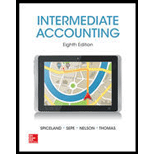
(1)
Held-to-maturity security: The debt securities which are held by the investor with an intent to hold the investment till its maturity, are referred to as held-to-maturity securities.
Debit and credit rules:
- Debit an increase in asset account, increase in expense account, decrease in liability account, and decrease in
stockholders’ equity accounts. - Credit decrease in asset account, increase in revenue account, increase in liability account, and increase in stockholders’ equity accounts.
To journalize: The purchase $240,000,000 of 6% bonds in the books of Corporation T
(2)
To journalize: The receipt of semiannual interest on December 31, 2016 in the books of Corporation T
(3)
To indicate: The amount of investment value as on December 31, 2016 in the books of Corporation T
(4)
To journalize: The sale of bonds on January 2, 2017 in the books of Corporation T
Want to see the full answer?
Check out a sample textbook solution
Chapter 12 Solutions
Intermediate Accounting w/ Annual Report; Connect Access Card
- I am trying to find the accurate solution to this general accounting problem with appropriate explanations.arrow_forwardI am trying to find the accurate solution to this general accounting problem with appropriate explanations.arrow_forwardPinecrest Industries, Inc., has collected the following data on one of its products. The actual cost of the direct materials used is:arrow_forward
- Please provide problem with accounting questionarrow_forwardGeneral accountingarrow_forwardPinecrest Industries, Inc., has collected the following data on one of its products. The actual cost of the direct materials used is: Direct materials standard (4 lbs. @ $3/lb) = $12 per finished unit Total direct materials cost variance (unfavorable) = $18,000 Actual direct materials used = 120,000 lbs. Actual finished units produced = 30,000 unitsarrow_forward

 AccountingAccountingISBN:9781337272094Author:WARREN, Carl S., Reeve, James M., Duchac, Jonathan E.Publisher:Cengage Learning,
AccountingAccountingISBN:9781337272094Author:WARREN, Carl S., Reeve, James M., Duchac, Jonathan E.Publisher:Cengage Learning, Accounting Information SystemsAccountingISBN:9781337619202Author:Hall, James A.Publisher:Cengage Learning,
Accounting Information SystemsAccountingISBN:9781337619202Author:Hall, James A.Publisher:Cengage Learning, Horngren's Cost Accounting: A Managerial Emphasis...AccountingISBN:9780134475585Author:Srikant M. Datar, Madhav V. RajanPublisher:PEARSON
Horngren's Cost Accounting: A Managerial Emphasis...AccountingISBN:9780134475585Author:Srikant M. Datar, Madhav V. RajanPublisher:PEARSON Intermediate AccountingAccountingISBN:9781259722660Author:J. David Spiceland, Mark W. Nelson, Wayne M ThomasPublisher:McGraw-Hill Education
Intermediate AccountingAccountingISBN:9781259722660Author:J. David Spiceland, Mark W. Nelson, Wayne M ThomasPublisher:McGraw-Hill Education Financial and Managerial AccountingAccountingISBN:9781259726705Author:John J Wild, Ken W. Shaw, Barbara Chiappetta Fundamental Accounting PrinciplesPublisher:McGraw-Hill Education
Financial and Managerial AccountingAccountingISBN:9781259726705Author:John J Wild, Ken W. Shaw, Barbara Chiappetta Fundamental Accounting PrinciplesPublisher:McGraw-Hill Education





